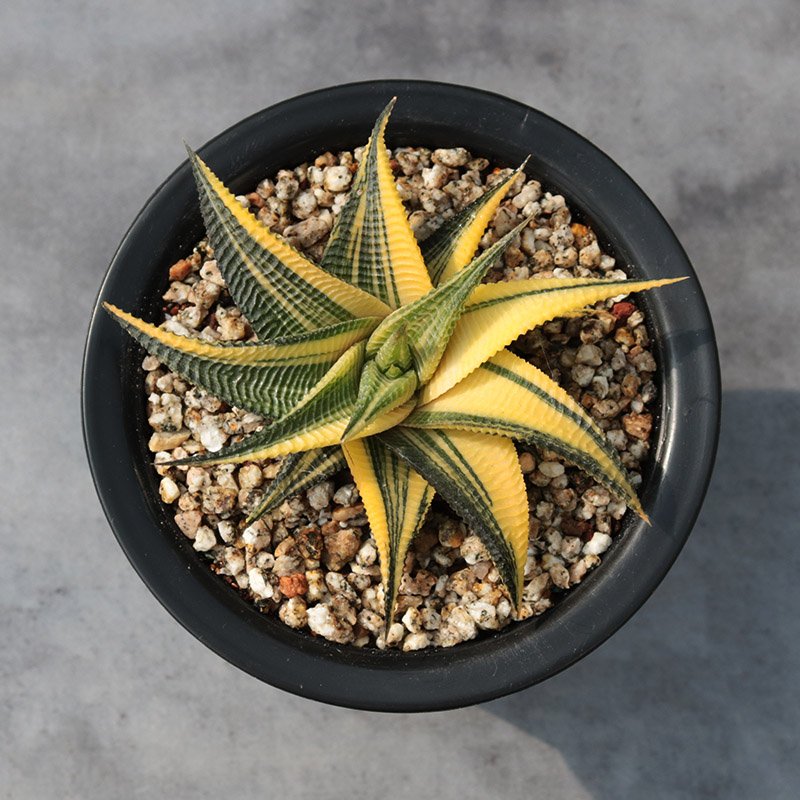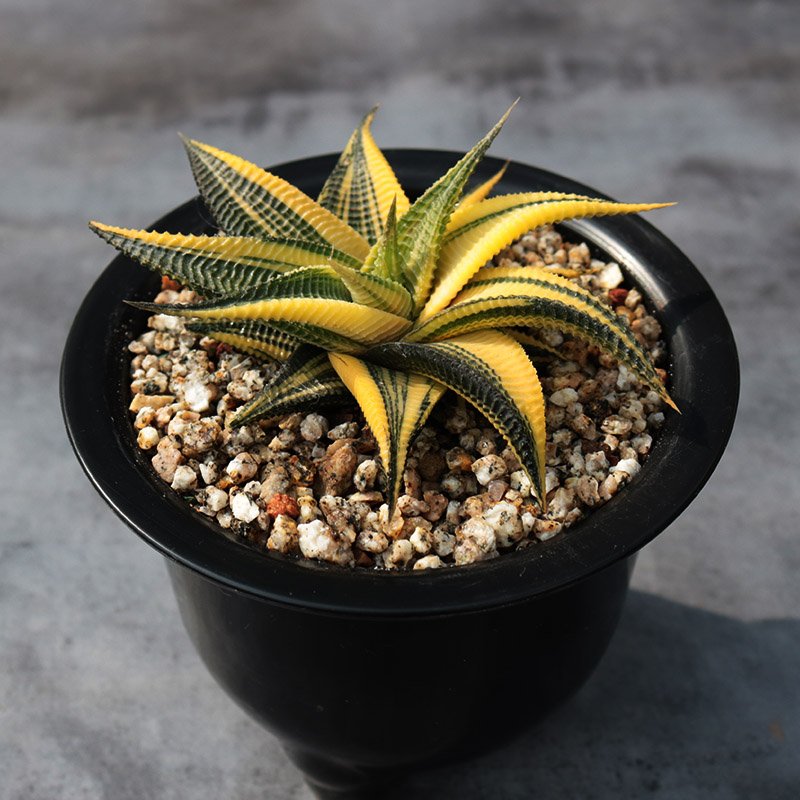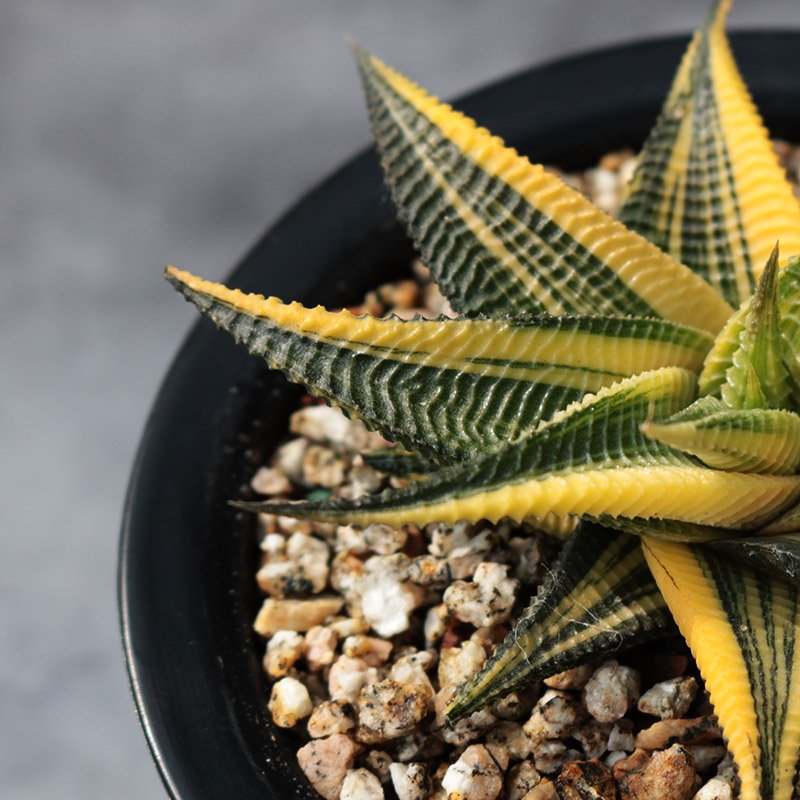
Want your haworthia limifolia variegated to grow well? Give it bright, but not direct, light. Water only when the soil is totally dry. Use soil that drains water fast. Put your plant in a pot with holes at the bottom. Keep the room temperature steady and the air dry. Do not water too much or use thick soil. Do not put your plant in strong sunlight. Taking care of your haworthia is easy if you follow these tips and watch your plant’s needs.
Key Takeaways
- Place your haworthia in bright, indirect light to keep its colors bright and avoid leaf burn.
- Water only when the soil is completely dry using the soak and dry method to prevent root rot.
- Use fast-draining soil and a pot with drainage holes to keep roots healthy and avoid soggy soil.
- Keep the plant in a warm room between 64°F and 75°F and avoid cold drafts or frost.
- Check your plant regularly for pests and diseases, and act quickly to keep it strong and beautiful.
Light for Haworthia

Placement at Home
Getting the lighting right is the first step to keeping your haworthia limifolia variegated happy. You want to give your succulent a spot with bright, indirect sunlight. Direct sun can burn the leaves, so you need to protect your plant from harsh rays. In nature, haworthia plants grow under rocks or bushes, where they get filtered light. You can copy this at home by placing your plant near a window that gets lots of light but not too much direct sun.
Tip: East-facing windows work great because they give gentle morning sunlight. South or west-facing windows also work if you keep your haworthia a few feet away from the glass or use a sheer curtain to soften the light.
Here are some good spots for your haworthia limifolia variegated:
- On a table near an east-facing window
- On a shelf close to a south or west window, but not right on the sill
- In a bright room with lots of natural light, away from strong afternoon sun
If you notice your plant stretching or leaning toward the light, it may need a brighter spot. If the leaves turn brown or dry at the tips, the lighting might be too strong.
Sunlight Needs
Haworthia limifolia variegated loves sunlight, but only the right kind. Too much direct sunlight can cause brown spots, leaf burn, or even kill the plant. Variegated succulents have less chlorophyll, so they burn faster than regular green plants. You want to give your haworthia enough light to keep its colors bright, but not so much that it gets damaged.
- Morning sunlight is gentle and safe for most haworthia plants.
- Afternoon sunlight is stronger and can harm the leaves, especially in summer.
- If you move your plant outside, do it slowly. Let it adjust to stronger sunlight over a week or two.
Lighting matters a lot for succulents. Good lighting keeps your plant compact and colorful. Poor lighting makes it stretch and lose its shape. Always watch your plant and adjust its spot if you see signs of trouble.
Watering Haworthia Care
How Often to Water
You might think succulents need a lot of water, but haworthia limifolia variegated is different. This plant stores water in its leaves, so it can handle dry spells. You should only water when the soil feels completely dry. If you water too soon, you risk root rot, which can kill your plant.
Here’s a simple guide for watering frequency:
- In spring and autumn, water once or twice a week. Always check the soil first.
- In summer, your plant may slow down and rest. Cut back on watering during this time.
- In winter, water just once a month. The plant goes dormant and needs less moisture.
Tip: If you’re not sure if the soil is dry, wait a few more days. It’s safer to underwater than overwater.
Watering Methods
The best way to water haworthia is the “soak and dry” method. This means you water deeply until water runs out of the drainage hole. Then, let the soil dry out completely before you water again. This method helps the roots grow strong and keeps them healthy.
Follow these steps:
- Place your pot in the sink or on a tray.
- Pour water slowly over the soil until it drains from the bottom.
- Let the pot drain fully. Never let water sit in a saucer under the pot.
- Wait until the soil is bone dry before watering again.
Avoid getting water between the leaves. Water trapped there can cause rot. Always use fast-draining soil, like a cactus or succulent mix, to help extra water escape quickly.
Note: Overwatering is the most common problem for haworthia growers. Signs include mushy or yellow leaves and a bad smell from the soil. If you see these, stop watering and let the plant dry out.
Seasonal Changes
Haworthia plants change their needs with the seasons. In spring and summer, they grow more and need a bit more water. In fall and winter, they rest and need much less.
Here’s how to adjust your care:
- Spring and summer: Water deeply but not too often. Let the soil dry out between waterings.
- Fall and winter: Cut back on watering. Once a month is usually enough. Make sure the soil dries out completely before you water again.
- If your home is very dry, you can mist around the pot (not on the leaves) to add a little humidity.
Water early in the morning. This gives the plant time to absorb moisture before the heat of the day and helps prevent rot.
Watch your plant for signs of trouble. Wrinkled or curling leaves mean it might need a drink. Mushy, yellow, or black leaves mean you watered too much. Always remember: haworthia care is about balance. When in doubt, wait before you water again. Your succulent will thank you!
Soil and Potting for Haworthia Limifolia Variegated

Best Soil Mix
Getting the right soil is one of the most important steps for your haworthia limifolia variegated. This succulent needs a mix that drains water quickly and does not hold onto moisture. If the soil stays wet, the roots can rot, and your plant will suffer.
You want to use a very porous potting mix. Look for a cactus or succulent soil at your local garden center. These mixes are made to let water flow through fast. If you want to make your own, try mixing regular potting soil with pumice, perlite, or chicken grit. Pumice works well because it does not float to the top and adds some nutrients. Perlite and grit also help keep the soil loose and airy.
Tip: Avoid using regular garden soil or mixes that hold water for a long time. These can cause root rot and other problems for your haworthia.
Here’s a simple recipe you can try at home:
- 2 parts cactus or succulent soil
- 1 part pumice or perlite
- 1 part coarse sand or chicken grit
This blend gives your plant the fast drainage it needs. The soil should feel gritty and dry out quickly after watering. A shallow pot with this kind of soil supports healthy roots and mimics the plant’s natural habitat.
Choosing a Pot
Picking the right pot is just as important as choosing the right soil. You want a pot that helps your haworthia stay healthy and happy. Always use a pot with drainage holes at the bottom. These holes let extra water escape, so the soil does not stay soggy. This simple step can save your plant from root rot.
Here are some reasons why drainage holes matter:
- They stop water from building up at the bottom of the pot.
- They help the soil dry out between waterings.
- They keep the roots from sitting in water, which can cause rot.
- They make it easier to follow the “soak and dry” watering method.
When it comes to pot material, terracotta is a great choice. Terracotta pots are porous, so they let moisture escape faster than plastic or glazed ceramic pots. This helps the soil dry out and keeps the roots healthy. If you use a plastic or ceramic pot, make sure it still has drainage holes.
Shallow pots work well for haworthia because these plants have shallow root systems. If your plant grows bigger or the roots fill the pot, you can move it to a slightly larger one. Always match the pot size to the root system. Too much extra space can hold water and slow down drying.
Note: Top-dressing the soil with a layer of gravel or small stones can help keep the leaves off wet soil and improve drainage even more.
Here’s a quick table to help you pick the best pot:
| Pot Material | Dries Quickly | Breathable | Good for Haworthia? |
|---|---|---|---|
| Terracotta | ✅ | ✅ | ✅ |
| Plastic | ❌ | ❌ | ⚠️ |
| Ceramic (glazed) | ❌ | ❌ | ⚠️ |
| Ceramic (unglazed) | ✅ | ✅ | ✅ |
Choose a pot that fits your style, but always put your plant’s health first. With the right soil and pot, your haworthia limifolia variegated will thrive and look its best.
Temperature and Humidity Care
Ideal Temperature
Your haworthia limifolia variegated likes things warm and steady. The best temperature range for this plant is between 64°F and 75°F. You can even let it get a bit warmer, up to 85°F, during the summer. Just make sure you keep it away from cold drafts or sudden temperature changes. Haworthias do not like frost at all. If the temperature drops below 41°F, your plant could get damaged.
Here’s a quick list to help you remember:
- Keep your plant in a room between 64°F and 75°F.
- It can handle up to 85°F in summer, but avoid hot, stuffy spots.
- Never let it get colder than 41°F.
- Protect it from cold windows or doors in winter.
- Good air flow at night helps keep your plant healthy.
Tip: If you move your haworthia outside in summer, bring it back in before the nights get chilly. This plant loves a mild climate and does best indoors where temperatures stay steady.
Humidity Tips
Haworthia limifolia variegated comes from dry places, so it does not need much humidity. Average indoor humidity, around 40-60%, works perfectly. You do not need to mist this plant or use a humidifier unless your home is very dry. Too much humidity can cause problems like root rot or fungal spots, especially if the soil stays wet.
Here are some ways to keep humidity just right:
- Use a well-draining soil mix with perlite or sand.
- Always plant in pots with drainage holes.
- Let the soil dry out completely before watering again.
- Avoid placing your haworthia near humidifiers or in bathrooms.
- If your air is very dry, group your plants together or use a small tray of water nearby (but not under the pot).
Note: If you see soft, mushy leaves or black spots, your plant might have too much moisture. Check the soil and let it dry out before watering again.
A little airflow goes a long way. Open a window or use a fan to keep the air moving. This helps prevent fungal problems and keeps your haworthia happy. With the right temperature and humidity, your plant will thrive all year long!
Fertilization, Repotting, and Propagation
Feeding Haworthia
You do not need to feed your haworthia often. This succulent has low nutrient needs and grows well with just a little help. During the growing season, which is spring through early autumn, you can use a diluted succulent fertilizer. Feed your plant once a month at most. Some gardeners only feed once in spring and once in summer. That is enough to keep your haworthia healthy and colorful.
Tip: Always use a fertilizer made for succulents. Too much food can make your plant stretch or lose its shape. If you repot with fresh soil or add slow-release pellets, you may not need to fertilize as often.
Repotting Tips
Repotting gives your haworthia a fresh start. Most plants need a new pot every two to three years. You should repot if your plant outgrows its pot, the roots look crowded, or the soil looks dry and old. Spring or early summer is the best time for this job.
Follow these steps for easy repotting:
- Gently remove your plant from its pot.
- Shake off old soil and check the roots.
- Trim any mushy or black roots.
- Place your haworthia in a pot just 1-2 inches bigger than before.
- Fill with well-draining soil made for succulents.
Note: Healthy roots help your plant grow strong. Always use a pot with drainage holes.
Propagation Steps
Propagating haworthia limifolia variegated is fun and simple. You can grow new plants from offsets, also called pups. These small plants grow around the base of the main plant. Wait until the pups are big enough to handle. Gently pull them away from the mother plant. Let the pups dry for a day so the ends heal. Then, plant them in their own pots with fresh succulent soil.
You can also try propagating by leaf cuttings, but offsets work best. Keep the new plants in a bright spot with indirect light. Water only when the soil is dry. Soon, you will have more haworthia to share or enjoy!
Care for Haworthia: Pests and Problems
Common Pests
You might not see pests often on your haworthia limifolia variegated, but it’s smart to check your plant now and then. Most indoor haworthias stay healthy, but sometimes pests sneak in. The main troublemakers are mealybugs, spider mites, scale, and sometimes aphids. Mealybugs look like tiny white cotton balls hiding in leaf crevices. Spider mites leave fine webs and cause yellow spots on leaves. Scale insects stick to stems and look like small brown bumps. Aphids are less common, but they can show up and suck sap from the leaves.
Here’s what you can do if you spot pests:
- Remove visible bugs with a cotton swab dipped in rubbing alcohol.
- Spray the plant with neem oil or insecticidal soap. Follow the label instructions.
- Isolate the affected plant so pests don’t spread.
- Wipe the leaves gently to keep them clean.
Tip: Regularly check under the leaves and between the leaf bases. Early action stops pests from spreading.
Disease Prevention
Diseases are rare if you follow good haworthia care, but overwatering can cause root rot. Root rot makes leaves turn mushy, yellow, or black. Sometimes you’ll notice a bad smell from the soil. Fungal spots can also appear if the air stays too damp.
To keep your plant healthy:
- Water only when the soil is dry.
- Use a pot with drainage holes and fast-draining soil.
- Make sure air can move around your plant.
- Remove any dead or mushy leaves right away.
A quick table for pest and disease signs:
| Problem | What You See | What To Do |
|---|---|---|
| Mealybugs | White cottony spots | Alcohol swab, neem oil |
| Spider mites | Fine webs, yellowing | Neem oil, increase humidity |
| Scale | Brown bumps | Scrape off, insecticidal soap |
| Root rot | Mushy, yellow leaves | Remove bad roots, repot dry |
Stay alert and act fast if you see trouble. With the right haworthia care, your plant will stay strong and beautiful.
Here’s a quick checklist to keep your haworthia limifolia variegated happy:
- Give it bright, indirect light
- Water only when the soil is dry
- Use fast-draining soil and a pot with holes
- Keep it warm and away from frost
- Feed lightly during spring and summer
- Watch for pests and remove them fast
Stick to these simple steps. You’ll see your haworthia thrive and look amazing. You’ve got this—caring for succulents can be easy and fun! 🌱
FAQ
How do I know if my haworthia needs water?
Touch the soil with your finger. If it feels dry all the way down, it’s time to water. If the leaves look wrinkled, your plant is thirsty. Always wait until the soil dries out before watering again.
Can I grow haworthia limifolia variegated outside?
You can grow it outside if the weather stays warm and frost-free. Keep it in a spot with bright, indirect light. Bring your plant inside before temperatures drop below 41°F. Too much rain or cold can harm your succulent.
Why are my haworthia’s leaves turning brown?
Brown leaves usually mean too much sun or overwatering. Move your plant to a spot with filtered light. Check the soil for moisture. Let it dry out before watering again. Trim any damaged leaves to keep your plant healthy.
Do I need to mist my haworthia?
No, you don’t need to mist this plant. Haworthia limifolia variegated prefers dry air. Misting can cause rot or fungal spots. Just water the soil when it’s dry, and your plant will stay happy.
How often should I repot my haworthia?
Repot your haworthia every two to three years. If you see roots coming out of the pot or the soil looks old, it’s time for a new pot and fresh soil. Spring is the best season for repotting.